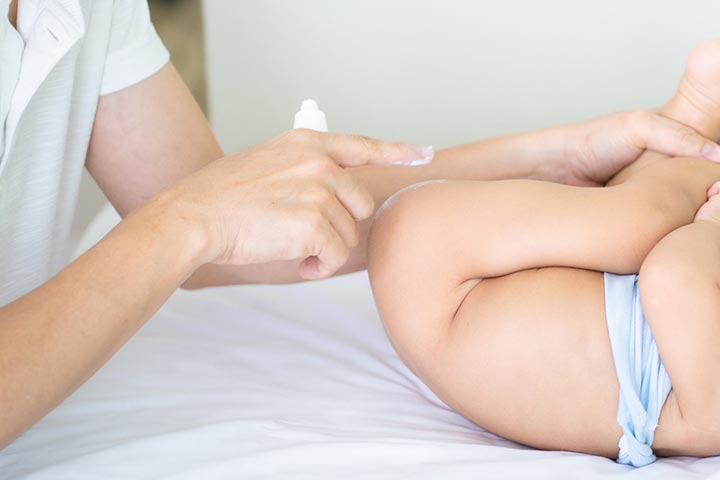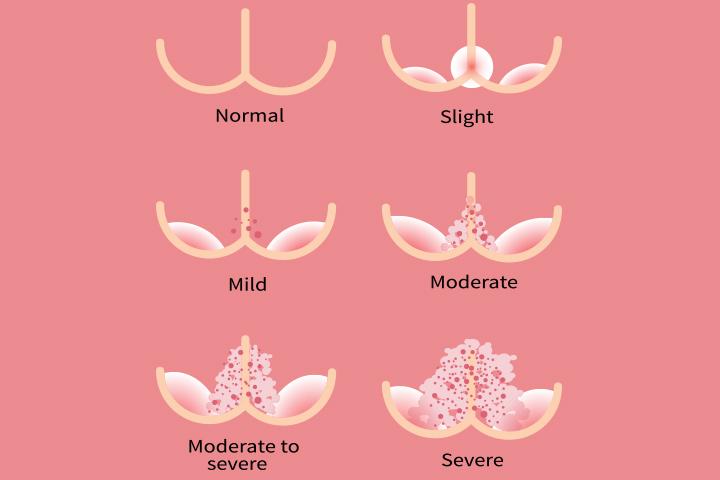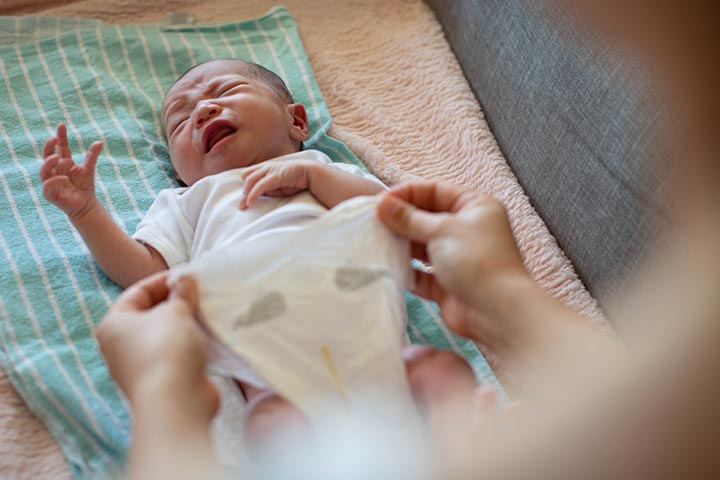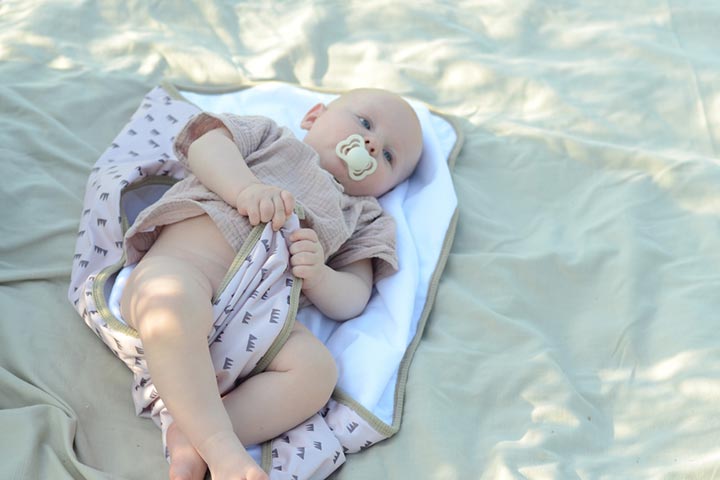Diaper dermatitis, also known as nappy rash, napkin dermatitis, or diaper rash, is a skin inflammation in the diaper area. Diaper rash in babies may happen for various reasons, including skin irritation and bacterial or fungal infections.
The condition is treatable at home if the diaper region is kept clean and dry. Some cases of persistent and severe diaper rash, on the other hand, may necessitate the use of prescription drugs. If the diaper rash does not improve with home remedies, you should see a doctor.
Read on to know more about the causes, symptoms, management, and prevention of diaper rashes in babies.
Causes Of Diaper Rash In Babies
The following factors may cause diaper rash in babies (1).
- Prolonged exposure to feces and urine may irritate the baby’s skin. Babies are vulnerable to diaper rash during diarrhea due to frequent bowel movements.
- Tight diapers or friction between the diaper and skin may cause rashes.
- Baby wipes, new diapers, detergent, baby lotions, creams, oils, and powders may cause skin irritation in some babies.
- Bacterial or fungal infections could cause diaper rashes.
- Antibiotic treatment may cause diaper rash due to changes in the skin’s microfloraiXDiverse helpful microorganisms on the skin surface and inside the body, resulting in yeast’s overgrowth. Diarrhea due to antibiotic treatment may also trigger diaper rash.
- Changes in diet, such as the introduction of solid foods or new foods, could cause diaper rash due to a change in the composition of the feces. Breastfed babies may have diaper rash due to changes in the maternal diet.
- Babies with atopic dermatitisiXAn inflammation of the skin accompanied by itchiness and dryness commonly triggered by an allergen or eczema may have an increased risk of developing diaper rash due to sensitive skin. According to the American Academy of Dermatology Association, eczema affects about 25% of all children, and 60% of these children begin to exhibit the symptoms during the first year of life.
The cause and severity of diaper rash in babies can vary. You may seek a pediatrician’s help for individualized evaluation and treatment to maintain a baby’s skin health.
Types Of Diaper Rash In Babies
Various types of diaper rashes in babies may look similar. However, having a closer look may help you identify the type of diaper rash and resolve it at the earliest possible.
The types of diaper rash in babies may include (2):
1. Irritant diaper rash
Irritant dermatitis is the most common cause of diaper rash in babies. Feces and urine are irritating substances, and the diaper area’s skin is always in contact with them. It can worsen during diarrhea. This may look like red or pink patches. It is less common to have irritant rashes on groin folds since it has less exposure to excrements.
2. Yeast infection
Overgrowth of yeast (a type of fungus) can cause diaper rash in many babies. Yeast infection (candida dermatitis) is commonly seen after antibiotic treatment. Bright red or pink, shiny patches with marked edges are a characteristic finding in yeast rashes. This may also appear as small pimples or bumps in the initial stages. You may notice sores or damaged skin that bleeds in severe cases. Yeast diaper rash can be more severe in groin folds.
3. Bacterial dermatitis
Babies may get bacterial diaper rash (impetigo) by strep and staph bacteria. This can also be a superimposed or secondary bacterial infection on an existing diaper rash due to other reasons.
The anal area may look bright red in strep infection. In comparison, staphylococcusiXA type of bacteria that can cause a variety of infections, including skin infections, commonly found on the skin and in the nasal passages or “staph” infection may cause honeycomb crusting (yellow crust) or pimples on the skin.
It is recommended to seek medical care for bacterial rashes since OTC antibiotic creams may worsen the condition.
4. Allergic dermatitis
Babies can have an allergic diaper rash due to certain substances in the diapers, baby wipes, creams, or powders. Fragrances, dyes, and elastics in a diaper may also cause allergic reactions. You may notice massive red and shiny allergic rashes all over the exposed skin. Hypoallergenic baby products or switching products may reduce allergies.
5. Other rare types of diaper rashes
The following skin conditions may often cause rashes in the diaper region. These may include:
- Seborrheic dermatitisiXA skin condition with red, scaly patches, typically treated with topical medications
- Pediatric psoriasisiXThe type of psoriasis that affects children, which is an autoimmune disease that causes inflammation and flaky patches on the skin
- Heat rash
- Acrodermatitis enteropathica (a genetic disorder with zinc deficiency)
You may notice other symptoms or rashes in other parts of the body in skin diseases caused by bacteria, viruses, or fungi. Always seek medical care for exact diagnosis if the home remedies do not improve diaper rashes within a few days or if the baby has severe rashes.
Symptoms And Signs Of Diaper Rash In Babies
Skin in the diaper area, such as buttocks, thighs, and genitals, may appear tender and red. Babies may cry or become fussy while changing diapers or washing their diaper region.
You may notice various skin changes, such as redness, flaky skin, and dry skin, depending on the causative factors (3).Skin bleeding, fever, unusual or severe rashes may indicate severe infections or skin conditions.
Diaper rashes can be really uncomfortable for babies. Linsay Boever, a mother, shares her experience dealing with her daughter’s diaper rash and her attempts to manage it. She says, “Poor Baby! She constantly has a diaper rash. She has the kind right now that I have to change her diaper every 20 minutes. It is crazy red and burns her so badly. I have tried Aquafor, Desitin, Coconut Oil, Lotrimin, and Corn Starch. I don’t use wipes. I give her a bath, wash her bottom every time with anti-bacterial soap then let her air dry for as long as I am able. But, nothing is helping and I want to cry every time I change her because she sucks her stomach in, sucks in air, and cries so hard (i).”
Treatment For Diaper Rash In Babies
The initial remedy for diaper rash prevention is to keep your baby’s skin dry and clean. Here are some home remedies that may help cure diaper rash in babies (4).
- Increase airflow to the diaper area
- Use larger diapers until rashes fade away
- Apply petroleum jelly or diaper creams and ointments that contain zinc oxide on the baby’s bottom where the rash is present
- Change soiled diapers immediately
- Give regular bath with warm water and fragrance-free soap until rashes disappear
- If it is caused by food, alter the diet; in the case of breastfed babies, change the maternal diet
The following complementary or alternative treatments may work for some babies (5).
- Human breast milk
- Winter bloom or witch hazel plant-based ointments
- Calendula diaper creams
- Aloe vera gel
- Bentonite or shampoo clay
- Olive oil
- Beeswax
- Primrose and honey mixture
The above-listed alternative remedies may work for some babies. However, some of these substances may increase bacterial growth in the diaper area. Therefore, seek advice from a pediatrician before using them.
If the diaper rash worsens or does not go away, a pediatrician or a pediatric dermatologist may prescribe any of the following treatments based on the cause (6).
- Mild hydrocortisone creams for inflammatory rashes
- Antifungal creams if rashes are due to fungal or yeast infection
- Antibiotic creams or ointments for bacterial infection
- Oral antibiotics are given for severe diaper rashes due to bacterial infections
Use the creams or ointments as per the doctor’s prescription since overuse can cause problems, and underuse may not be effective.
Prevention Of Diaper Rash In Babies
Keeping the diaper area dry and clean is the best way to prevent most diaper rashes in babies. The following tips may help to avoid diaper rashes in babies (1) (6).
- Change diapers on time, wearing wet and dirty diapers for extended periods may increase the risk of rashes.
- You may clean the diaper area with lukewarm water, baby wipes, cotton balls, or washcloths while changing diapers.
- Avoid using baby wipes with alcohol or fragrance. You may use a cotton cloth soaked in warm water to clean the diaper area during a rash.
- Pat dry the skin after cleaning with a towel and air dry the diaper area before putting on the new
- Avoid over-tightening the diapers since lack of airflow and friction may increase the risk of skin irritation.
- Let your baby stay diaper-free for some time each day to reduce the risk of skin problems in the diaper area. You may keep them on a baby sheet or large towels to avoid any messy accidents.
- Use a thick layer of diaper creams (barrier creams or pastes) to protect the baby’s skin from irritants.
- Highly absorbent diapers may reduce skin irritation by absorbing the excrements.
- Wash your hand after diaper changes to prevent diaper rash spread to other parts of the baby’s body.
Although many prefer baby powders or cornstarch powder for absorbing excess moisture in the skin, experts do not recommend powders since inhaled powders may irritate a baby’s lungs.
Are Disposable Diapers Better Than Cloth Diapers?
Choosing diapers for babies can often be confusing for many parents. Cloth diapers can be environmentally friendly, but disposable diapers are more convenient for most parents. However, when it comes to diaper rash, both the diapers can cause it, and there is no evidence that one is better than the other. So, you may choose a diaper according to your convenience and what works best for your baby.
Note: When your baby has a diaper rash, it is better to use disposable super-absorbent diapers than cloth diapers (6).
If diaper rash happens after using cloth diapers, try to change the fabric softeners and detergents. You may try a different brand if a disposable diaper causes skin inflammation. However, changing the diaper on time and keeping the diaper area dry and clean is a better way of preventing diaper rash.
Baby diaper rash can be triggered by several factors, including tight diapers; bacterial or fungal infections; and allergies to certain baby wipes, lotions, or powders. They can also be of different types, such as instant dermatitis, yeast infection, and bacterial dermatitis. Identifying the type and cause of the rash can help resolve the issue faster. They can usually be treated at home by applying petroleum jelly or ointments with zinc oxide to the affected area. Regular warm water baths and increased airflow in the diaper area can also help. However, consult your pediatrician if your baby has severe rashes and bleeding to ensure they get the right diaper rash treatment.
Key Pointers
- A diaper rash is very common in babies and mostly appears due to prolonged exposure to urine or feces, mild irritation, or underlying inflammation.
- Simple remedies such as frequent diaper changing, allowing free airflow in the diaper area, and applying diaper creams could help.
- If your baby is crying incessantly due to diaper rashes, it is wise to contact a pediatrician.
Diaper rash is a common condition that can make your baby uncomfortable all day long. Learn how to prevent and treat diaper rash quickly and effectively with this helpful video!















